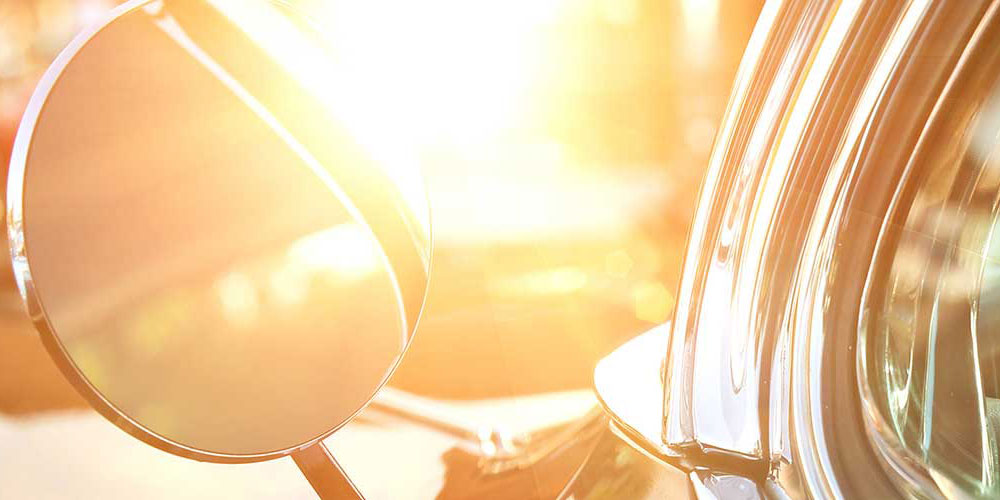by A. Wayne Ferens
Images Courtesy of Ford Motor Company Archives, Wayne Ferens Collection
Published 11.1.2023
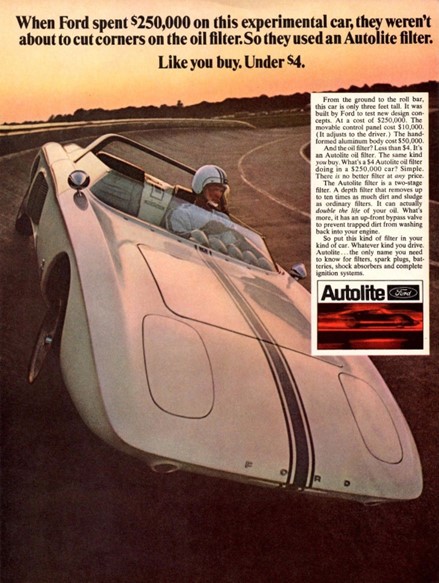 Ford's revolutionary new sports car concept called the Mustang I was the first to use the Mustang name. It was conceived by a team of Ford designers and engineers that included Eugene Bordinat, John Najjar and Roy Lund. These types of ads were typically featured in auto magazines to appeal to younger buyers and give the company a forward-looking image. (Ford Motor Company Archives)
Ford's revolutionary new sports car concept called the Mustang I was the first to use the Mustang name. It was conceived by a team of Ford designers and engineers that included Eugene Bordinat, John Najjar and Roy Lund. These types of ads were typically featured in auto magazines to appeal to younger buyers and give the company a forward-looking image. (Ford Motor Company Archives)
Ford's revolutionary new sports car concept called the Mustang I was the first to use the Mustang name. It was conceived by a team of Ford designers and engineers that included Eugene Bordinat, John Najjar and Roy Lund. These types of ads were typically featured in auto magazines to appeal to younger buyers and give the company a forward-looking image. (Ford Motor Company Archives)
The 1960s were a time of change, especially for the American automobile industry. The industry was consolidating into the Big Three: General Motors, Ford and Chrysler. These three firms dominated the domestic market, building 90 percent of the vehicles sold in the United States. Competition was raging, especially with the advent of economy, muscle, and pony cars. Manufacturers emphasized performance and style in their new designs to attract the young "Baby Boomer" buyers looking for something fresh and exciting. The smaller imports were growing in popularity with these younger buyers, so Detroit's Big Three quickly responded with the Chevy Corvair, Chrysler Valiant and the Ford Falcon.
Every major car company had their own Design & Styling Studio manned with talented designers, artists, draftsmen and modelers who couldn't create and “leak” their new ideas fast enough to the media. They worked tirelessly to build their much anticipated "Concept Cars" in time for the next issue of Car and Driver, Motor Trend or Car Craft Magazine to stay one step ahead of the competition.
In the fall of 1962, Ford had a better idea and created the Ford Custom Car Caravan under the leadership of Ford Special Projects Division head Jacques H. Passino that would take their new “Concepts” and put them on display directly in front of the buying public at their local auto or custom car show. Ford's Car Caravan traveled the United States through 1965 and featured customs from some of the industry’s best designers and car builders, including their own Eugene Bordinat and John Najjar. Ford reached out to prominent car builders and customizers, including Vince Gardner, Harry Bradley and the legendary Gene Winfield and George Barris, to commission additional custom cars for the tour.
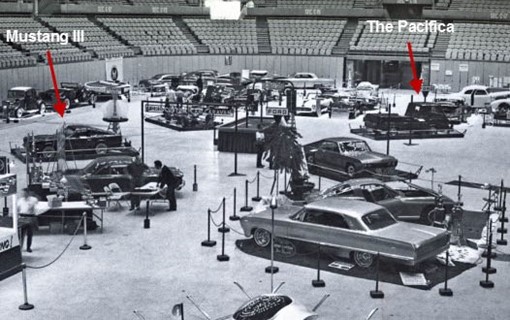 The Ford Custom Car Caravan being set up at a 1964 Pittsburgh car show (Ferens Collection)
The Ford Custom Car Caravan being set up at a 1964 Pittsburgh car show (Ferens Collection)
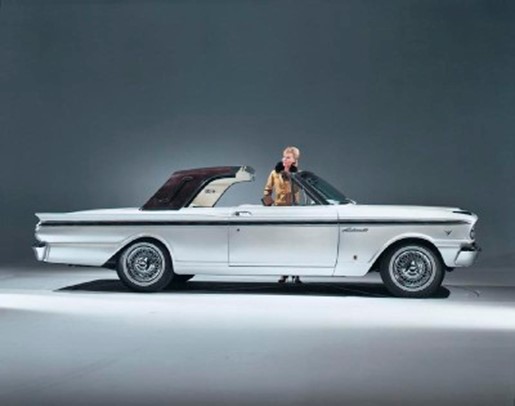 Detroit's "Big Three" became interested in the west coast customizers when Ford Motor Company commissioned George Barris to upgrade this 1963 Fairlane for the Caravan that toured major custom auto shows across the nation. Ford called it the Fairlane 500 Landau Starburst. (Ferens Collection)
Detroit's "Big Three" became interested in the west coast customizers when Ford Motor Company commissioned George Barris to upgrade this 1963 Fairlane for the Caravan that toured major custom auto shows across the nation. Ford called it the Fairlane 500 Landau Starburst. (Ferens Collection)
This 1963 Ford Astro concept was created by Bill Cushenberry at his Custom Shop in Monterey, California. It is based on a Ford Galaxie Convertible and used the round light styling theme as motif for the front end that was popular on Ford products at the time. Ford invited Cushenberry to take part in the Custom Caravan after seeing the award-winning custom car he designed and named the Silhouette. (Ferens Collection)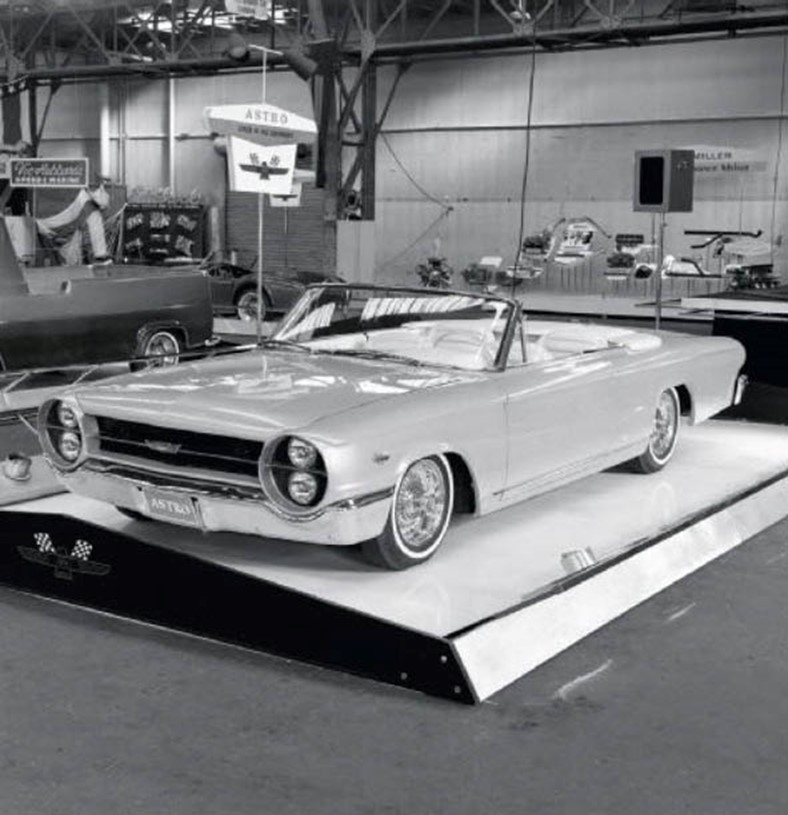 This 1963 Ford Astro concept was created by Bill Cushenberry at his Custom Shop in Monterey, California. It is based on a Ford Galaxie Convertible and used the round light styling theme as motif for the front end that was popular on Ford products at the time. Ford invited Cushenberry to take part in the Custom Caravan after seeing the award-winning custom car he designed and named the Silhouette. (Ferens Collection)
This 1963 Ford Astro concept was created by Bill Cushenberry at his Custom Shop in Monterey, California. It is based on a Ford Galaxie Convertible and used the round light styling theme as motif for the front end that was popular on Ford products at the time. Ford invited Cushenberry to take part in the Custom Caravan after seeing the award-winning custom car he designed and named the Silhouette. (Ferens Collection)
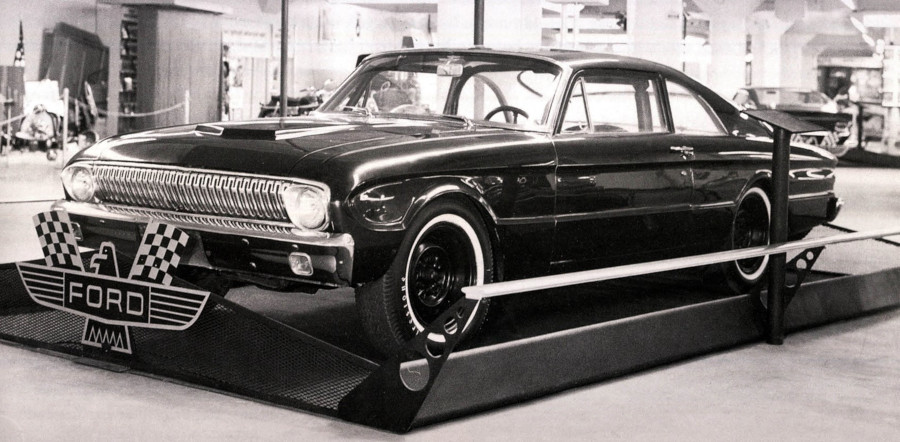 This base 1963 Falcon was transformed into a 289 V8-powered high performance competition coupe with its unusual NASCAR-inspired fastback roof and sectioned body. It was modified by the famous American race car manufacturer Holman-Moody in Charlotte, North Carolina. (Ferens Collection)
This base 1963 Falcon was transformed into a 289 V8-powered high performance competition coupe with its unusual NASCAR-inspired fastback roof and sectioned body. It was modified by the famous American race car manufacturer Holman-Moody in Charlotte, North Carolina. (Ferens Collection)
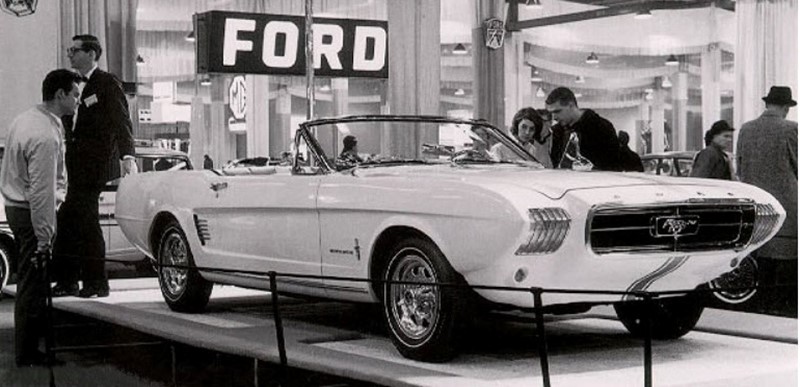 The Mustang II concept car was designed by Ford’s Eugene Bordinat and John Najjar. It closely resembled the final production variant that was introduced in April 1964. The Mustang II was fabricated by Vince Gardner of Dearborn Steel Tubing Company. Gardner and DST also fabricated the Mustang III, a unique fiberglass bodied two-seat Mustang fastback on a shortened wheelbase for the Caravan. (Ferens Collection)
The Mustang II concept car was designed by Ford’s Eugene Bordinat and John Najjar. It closely resembled the final production variant that was introduced in April 1964. The Mustang II was fabricated by Vince Gardner of Dearborn Steel Tubing Company. Gardner and DST also fabricated the Mustang III, a unique fiberglass bodied two-seat Mustang fastback on a shortened wheelbase for the Caravan. (Ferens Collection)
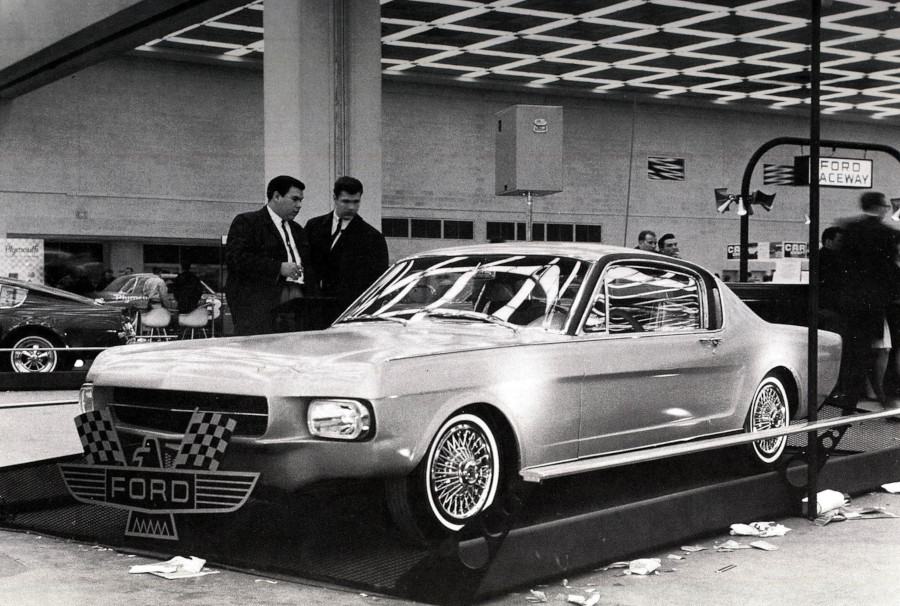 This 1965 Mustang Fastback was called the Pegasus and included in the Custom Caravan. It was customized by Fostoria Styling. Note the Mustang III Fastback on the left. (Ferens Collection)
This 1965 Mustang Fastback was called the Pegasus and included in the Custom Caravan. It was customized by Fostoria Styling. Note the Mustang III Fastback on the left. (Ferens Collection)
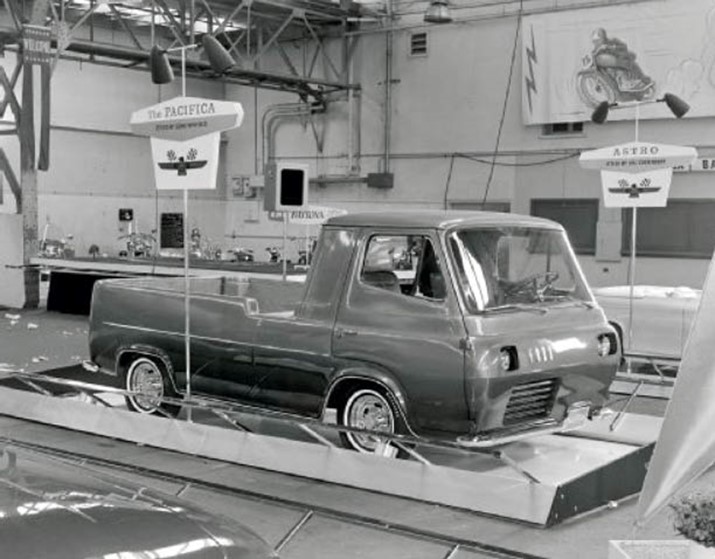 One of the most popular vehicles in the Caravan was the restyled Ford Econoline E-100 pickup transformed by Gene Winfield called the Pacifica. Winfield is one of the premier customizers in the world. He has been building cars at his shop in Mojave, California for over 60 years. (Ferens Collection)
One of the most popular vehicles in the Caravan was the restyled Ford Econoline E-100 pickup transformed by Gene Winfield called the Pacifica. Winfield is one of the premier customizers in the world. He has been building cars at his shop in Mojave, California for over 60 years. (Ferens Collection)
Ford outsourced the custom cars for the Caravan for several reasons. The independent contractors were able to build them faster and for less money. Ford would provide the basic concept they wanted, and even provided sketches and artwork. Ford paid a commission and provided a budget for the design and build. The custom shops were free to modify and build the vehicle within the budget. Ford also paid the designers and builders for appearances at the Caravan shows. After the last Custom Car Caravan ended in the 1965-1966 show season, Ford sold it to Indy race car driver Troy Ruttman Jr., who was later killed in a race at the Pocono Speedway in 1969. Many of the Caravan cars were destroyed or given to the sub-suppliers. Some were donated -- like the Mustang II that is part of the Detroit Historical Society collection.
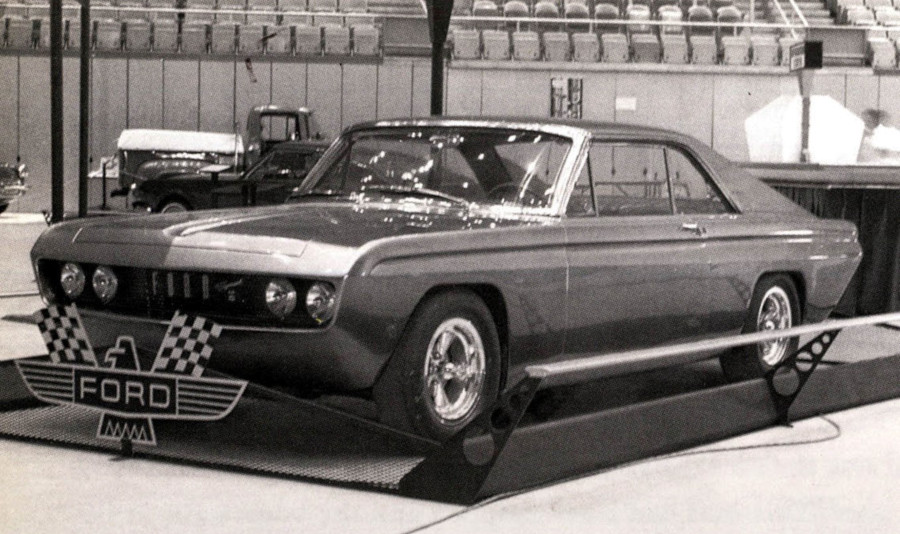 This wild custom 1964 Falcon Futura coupe was called the Python and built by Dean Jeffries in just three weeks at his Los Angeles shop. It featured radical body work and interior with candy apple burgundy into black duco paint. (Ferens Collection)
This wild custom 1964 Falcon Futura coupe was called the Python and built by Dean Jeffries in just three weeks at his Los Angeles shop. It featured radical body work and interior with candy apple burgundy into black duco paint. (Ferens Collection)
The final season of the Caravan switched its focus to performance more than customizing, just as young buyers moved away from customs to muscle cars. The Caravans showed that Ford Motor Company was a proponent of custom cars, and the company's efforts gave recognition to those designers and custom car builders that they so richly deserved.
Bibliography:
Ford Motor Company
Hemmings
Motor Trend
Car Craft magazine


